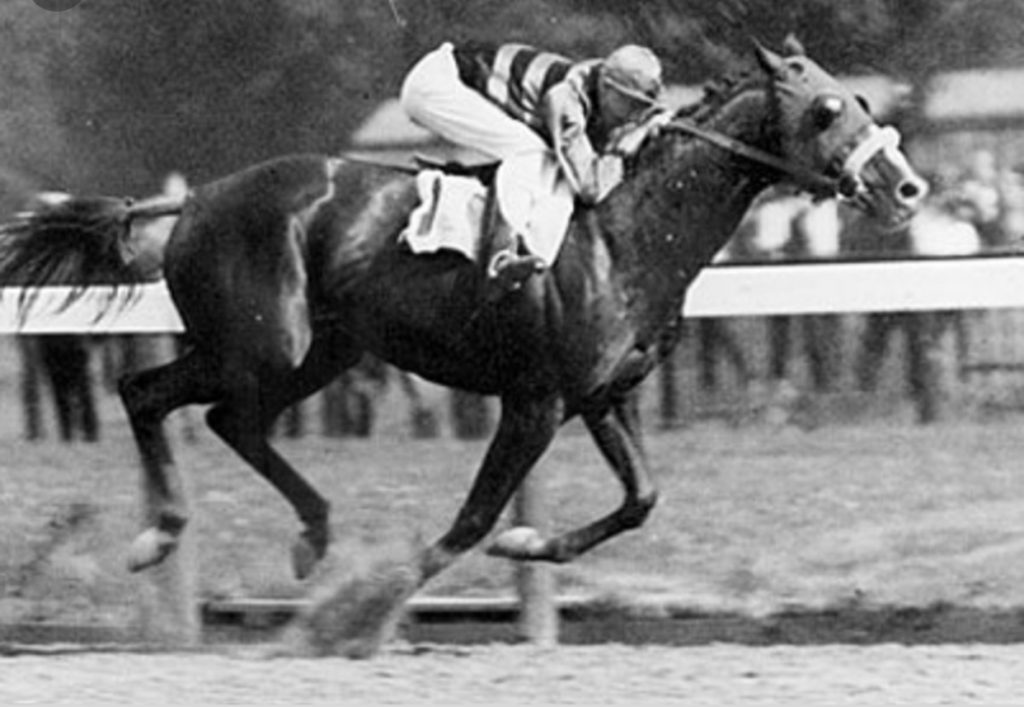
The road to the Kentucky Derby is paved with points: if you want to make it into the gate, your horse must win the right races to get there. That massive gate has space for only twenty horses at a time, twenty out of the 22,500 foaled in North America in 2016. The road to Derby glory is paved with points, luck, and talent. To be part of the 0.09% that will enter the gate on May 4, 2019, a great many things must go your way.
One hundred years ago, it was simpler to make it to the Kentucky Derby: all an owner needed was money and a horse worth entering. The subscription fee for the race was $25; to meet the barrier, another $250. In 1919, with World War I over and the country ready for peace and prosperity, the Kentucky Jockey Club wanted to capitalize on rising interest in horse racing and announced that the Derby’s purse would be $20,000 in 1919, up from $15,000 the year before. On May 10th, the Kentucky Derby had twelve horses meeting the barrier, a larger field than 1918’s edition. The extra money had attracted more horses to Louisville, including the first Derby entries for Commander John Kenneth Leveson Ross, the Canadian sportsman who was in the process of building a powerhouse stable and wanted a Kentucky Derby to add to the roster of races he had already won. His starters? Billy Kelly, the 1918 two-year-old co-champion, and Sir Barton, a colt with a royal pedigree who had yet to win his first race.
One would win and the other would come in second, but their unexpected order of finish would set off a historic run through the American classics that celebrates its 100th anniversary in 2019. The road to Louisville for Sir Barton was one paved with potential finally realized on the brightest of days in 1919.
Sir Barton Goes to the Races
Sir Barton’s place at the barrier for the Kentucky Derby might have seemed inevitable from birth. His sire, Star Shoot, had been the country’s leading sire for most of the decade; his dam Lady Sterling already had birthed another champion, Sir Martin, who was leading the 1909 Epsom Derby until he fell in the latter part of the race. His breeder John E. Madden had made his reputation as the “Wizard of the Turf” on his judgement about the breeding and racing of Thoroughbreds. For the colt’s two-year-old season in 1918, Madden kept Sir Barton to race in his own colors as a two-year-old, while shopping the colt to other owners looking for a good colt to add to their stables.
The problem was, Sir Barton looked great in morning workouts, but had the habit of finishing toward the back of the pack in his races. Despite being trained by famed African American jockey-turned-trainer William Walker, Sir Barton had yet to show his morning form when it mattered, but Madden was not deterred. He had his sights set on Commander Ross, who was all in on building a stable of champions. Trainer H.G. Bedwell had been watching the chestnut colt and saw the latent potential inherent in Sir Barton.
While Ross was at Saratoga, he also had seen the two-year-old gelding Billy Kelly win several races, including handicaps where he had been asked to carry more weight than a horse that young typically would. After a loss in one of those handicaps, Billy Kelly’s owner W. F. Polson sold the gelding to Commander Ross. Billy Kelly was now part of the Ross Stable, and, if he stayed healthy, Commander Ross was sure to have his Derby horse.
Joining Billy Kelly in the Ross orange and black was Sir Barton. Madden finally sealed the deal at Saratoga in August 1918, for a reported $10,000. Sir Barton was a maiden still, but H.G. Bedwell saw that his new colt worked best with a partner and, when he had one, he usually beat them. Sir Barton seemed ready for his next start, the Hopeful Stakes, but rewarded his new owner with another up-the-track finish, 16th out of 20 horses. The winner of the Hopeful was a colt named Eternal, who by virtue of his victory in that race and four others, became the challenger to Billy Kelly’s claim on the two-year-old championship. In order to determine which horse was best, Commander Ross and Eternal’s owner J.W. McClelland agreed to a match race between their horses at Laurel in October 1918. This match race would set in motion a series of decisions that resulted in America’s first Triple Crown.
A Kick, a Cut, & a Question
September brought Sir Barton to Belmont Park and the legendary Futurity, the most prestigious juvenile race of the era. A horse had to be nominated for the Futurity at birth, so one of Commander Ross’s motivations for buying Sir Barton was his eligibility for the race as well as the progress the colt was making in his morning workouts. Despite five earlier starts with finishes well out of the money, Sir Barton finished second in the Futurity, a race where he was hampered by traffic but came with a rush at the race’s end. Had the colt had more distance, he probably would have caught the winner, Dunboyne, at the finish. Finally, Sir Barton was showing his talent in races, not just in workouts. Bedwell entered his rising star in several races in the stable’s home state of Maryland while the drumbeat for the Billy Kelly-Eternal match race grew louder.
One mid-October morning, the Ross horses were out at Laurel for their morning exercise. Sir Barton worked six furlongs in 1:13, indicating that the colt was ready for his next start. However, at some point that morning, Sir Barton got too close to stablemate Foreground, who lashed out and struck Sir Barton in the stifle of his hind leg. The kick opened up a cut on Sir Barton’s hind leg, and soon the cut became infected. H.G. Bedwell nursed Sir Barton through blood poisoning and a dangerous fever, relying on his years of experience with horses to help the colt survive this crisis.
Sir Barton recovered from his illness, but it cut short his 1918 season, leaving him with no other races as 1918 gave way to 1919. The question was, would Sir Barton be ready for 1919?
Match Race Debate
The match race between Billy Kelly and Eternal had been scheduled for October 24th, but the Spanish influenza outbreak that month delayed the race until October 28th. Billy Kelly, with Earl Sande, and Eternal, with Andy Schuttinger, went to the barrier for the John R. McLean Memorial Cup. Billy Kelly took the lead at the start, but Sande had orders to keep Billy Kelly with Eternal.
When Sande slowed his mount, Schuttinger sent Eternal to the lead, nearly two lengths ahead of Billy Kelly after the first quarter of the six-furlong race. Realizing he was too far back, when Eternal bore out wide on the final turn, Sande tried to duck Billy Kelly in toward the rail. Schuttinger, gambling that Sande would do just that, sent Eternal back in toward the rail right as Billy Kelly moved, cutting off the gelding’s run. By the time Sande got Billy Kelly clear to challenge Eternal, the race was in its final throes. With each stride, the gap shrunk; as they hit the wire, Eternal had a head advantage over Billy Kelly. In the next stride, Billy Kelly passed his rival, but the race was over.
Commander Ross, eager for a rematch, agreed to a second match race; J.W. McClelland opted to rest Eternal for the remainder of 1918, with the intention of pointing him toward the 1919 Kentucky Derby. The debate about who was better – Billy Kelly and Eternal – would not be decided in 1918, but would have to wait for Louisville and the Run for the Roses.
Derby Decisions
With the Billy Kelly-Eternal debate still raging, Billy Kelly started his 1919 season off winning handicaps against older horses while Eternal trained out in Arkansas at Oaklawn Park. Commander Ross was an enthusiastic gambler and he was definitely betting on Billy Kelly not only making it to the Derby, but winning it. Others, however, fell on the side of Eternal, including notorious underworld figure Arnold Rothstein. Rothstein surprised Ross with a wager of $50,000 that Eternal would beat Billy Kelly in the Derby. Ross accepted the proposition, confident in his gelding and the form he was showing.
As the Ross Stable counted down to Louisville, Commander Ross purchased two other three-year-olds from A.K. Macomber, bringing his total of potential Derby starters to five, including Billy Kelly. How many horses would he enter in the Kentucky Derby? Who else was worthy of joining the gelding in Louisville?
Recovered from his near-death experience in October, Sir Barton had showed himself to be head and shoulders above the rest of the Ross’s potential Derby starters. A workout in late April at Havre de Grace saw first Billy Kelly and then Cudgel run with Sir Barton, who ran 1 1/8 miles in 1:54 3/5. It was clear which of Ross’s horses was making the most progress toward being ready for a race like the Kentucky Derby. Sir Barton had not raced since September and had survived a serious illness, yet, when the time came and Billy Kelly was loaded on a railcar bound for Louisville, in that same car was Sir Barton. The rest is history.
A century later, getting to Louisville requires the same combination of luck and talent that Sir Barton needed to win the Kentucky Derby with an added wrinkle: points. The field is bigger and the road tougher, but any horse worth of winning the Run for the Roses now still must possess what America’s first Triple Crown winner had in 1919: that unnamable something special, that little bit extra it takes to come home first. That combination of talent and heart will always be necessary to win the Kentucky Derby.
Read more about the 1919 Kentucky Derby and America’s first Triple Crown in Jennifer Kelly’s book Sir Barton and the Making of the Triple Crown, coming soon from the University Press of Kentucky. Keep up with Jennifer on her blog, The Sir Barton Project.



